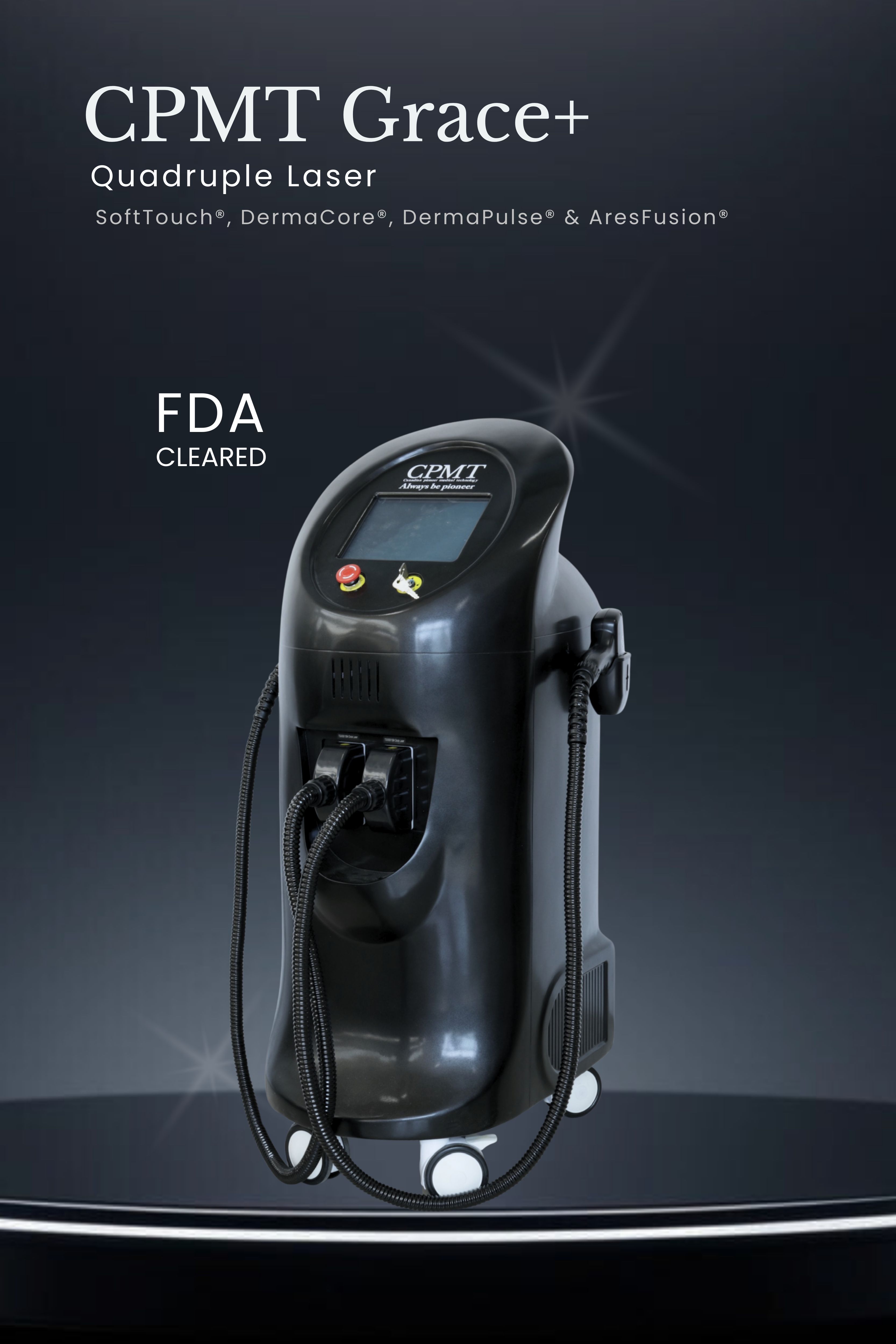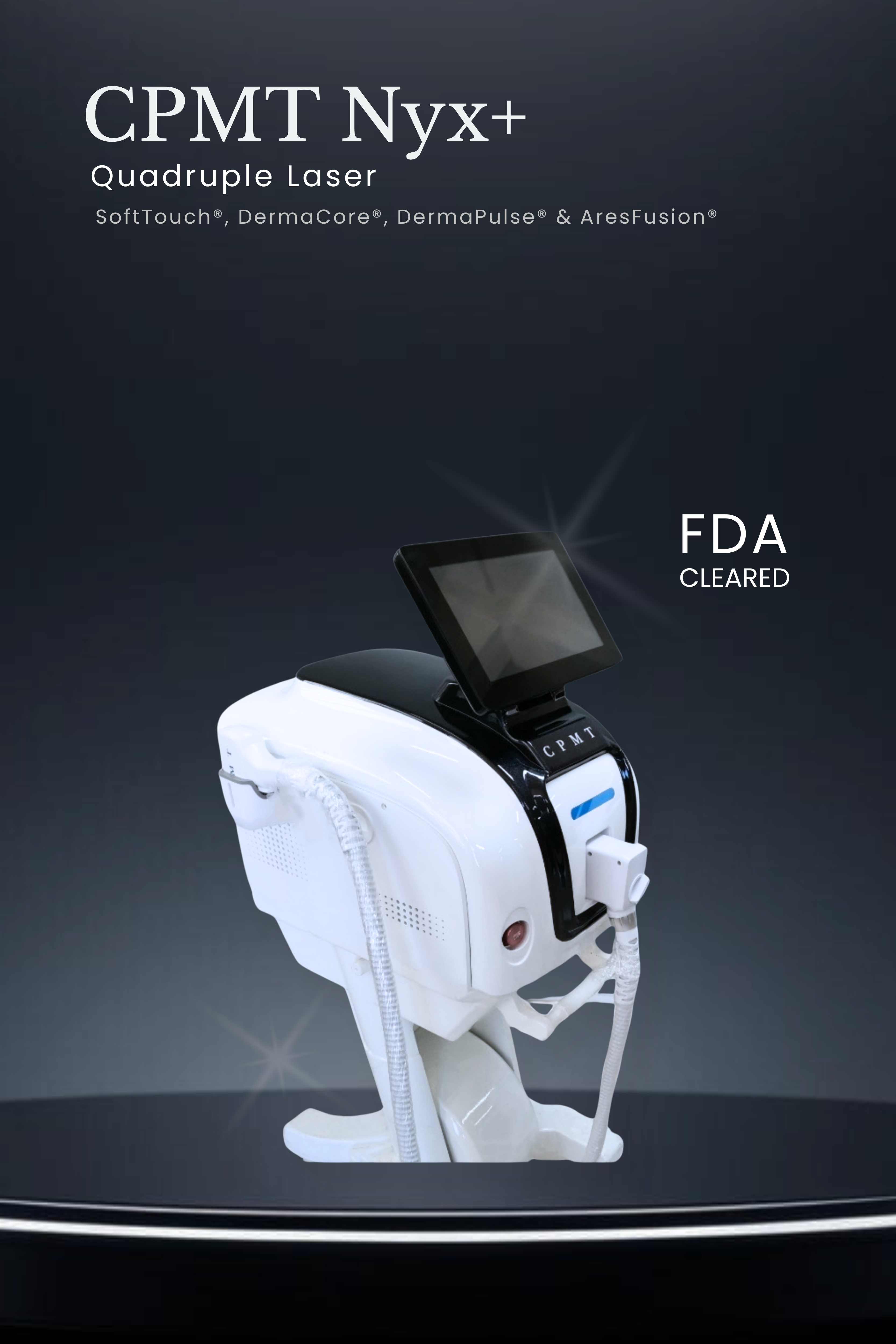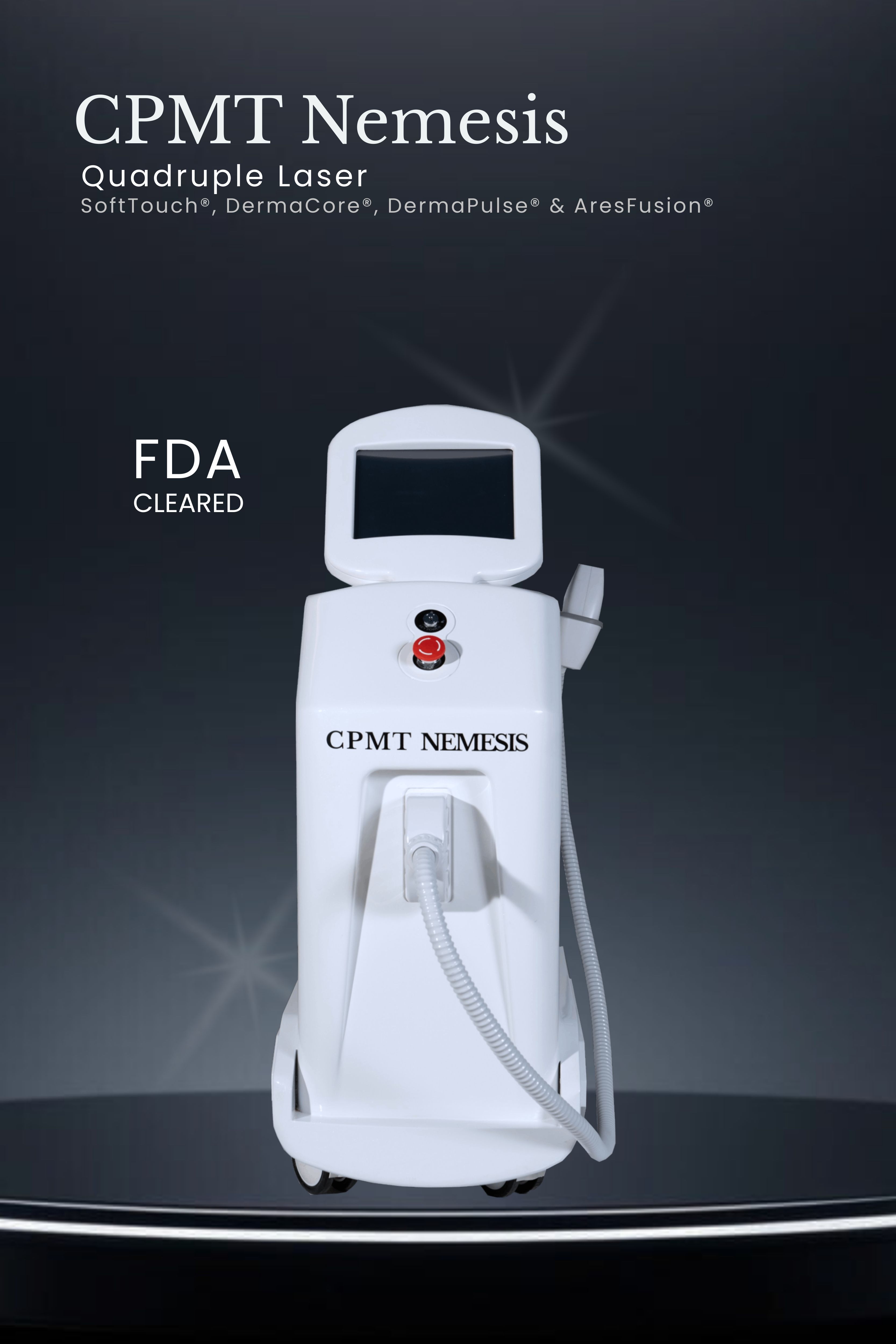Product description
Key Features and Benefits:
- Permanent Hair Removal (HR): CPMT Ares effectively targets and removes all hair types, including finer and thicker hairs, across all skin types.
- Versatility: The four handpieces (SoftTouch, DermaPulse, DermaCore, and AresFusion) address a wide spectrum of skin and hair conditions.
- Precision: Customizable wavelengths ensure targeted treatment for optimal results.
- Safety: Prioritizes patient safety with low fluence and high-frequency laser delivery, minimizing discomfort and risk.
- Efficiency: Rapid treatment times and long-lasting results.
- Effectiveness: Beyond hair removal, CPMT Ares treats a variety of vascular and pigmented lesions.

In Treatment of Benign Vascular Lesions:
CPMT Ares is effective in treating various benign vascular lesions, including:
- Spider Veins (Telangiectasia): Small, dilated blood vessels near the skin’s surface, often on the face or legs.
- Cherry Angiomas: Small, red to purple growths made up of clusters of capillaries.
- Hemangiomas: Benign tumors of blood vessels, appearing as red or purple bumps.
- Port-Wine Stains: Flat, reddish-purple birthmarks caused by dilated blood vessels.
- Venous Lakes: Dark blue to purple papules on sun-exposed areas like the lips and ears.
- Pyogenic Granulomas: Small, raised red bumps prone to bleeding, often from injury.
- Nevus Flammeus (Stork Bite/Salmon Patch): Birthmarks caused by dilated capillaries, usually on the neck or forehead.
- Capillary Malformations: Red or pink discolorations due to capillary abnormalities.
- Venous Malformations: Abnormal veins appearing as bluish or purplish patches or nodules.
- Angiokeratomas: Small, dark vascular lesions on the skin or mucous membranes.
In Treatment of Vascular-Dependent Lesions:
CPMT Ares also targets vascular-dependent lesions, such as:
- Port-Wine Stains
- Hemangiomas
- Pyogenic Granulomas
- Spider Veins (Telangiectasia)
- Venous Lakes
- Capillary Malformations
- Venous Malformations
- Angiokeratomas
- Nevus Flammeus (Stork Bite/Salmon Patch)
- Arteriovenous Malformations (AVMs)
- Telangiectatic Matting
- Lymphangiomas
- Senile Purpura
- Spider Angiomas
- Erythema Ab Igne
- Rhinophyma
- Nevus simplex (Angel’s Kiss/Burnt Nevus)
- Capillary Hemangiomas
- Telangiectasias
In Treatment of Pigmented Lesions:
CPMT Ares is effective in treating various pigmented lesions, including
- Freckles (Ephelides): Small, light brown spots typically found on sun-exposed skin.
- Lentigines (Age Spots or Liver Spots): Flat, brown spots from sun exposure or aging.
- Nevus (Mole): Pigmented skin lesions varying in color, shape, and size.
- Seborrheic Keratosis: Non-cancerous growths that are slightly elevated and often pigmented.
- Melasma: Dark, symmetrical patches of skin discoloration usually on the face, often related to hormonal changes.
- Solar Lentigines: Similar to age spots, caused by prolonged sun exposure.
- Becker’s Nevus: A large, pigmented birthmark with a slightly raised, coarse texture.
- Dermatofibroma: Benign fibrous nodules with a brownish or reddish color.
- Nevus of Ota: A pigmented lesion around the eyes and cheeks, often blue-gray.
- Nevus simplex: Flat, pink, or red birthmarks, often called “angel’s kiss” or “salmon patch” when seen in infants.
- Cafe-au-Lait Spots: Light brown spots that may appear anywhere on the body, sometimes linked to genetic conditions.
- Blue Nevus: A benign, blue, or blue-gray mole, often on the face or extremities.
- Keloids: Raised, pigmented scars resulting from excessive scar tissue production.
- Junctional Nevus: A mole located at the epidermis-dermis junction.
- Compound Nevus: A mole extending into the dermis, often raised.
- Intradermal Nevus: A mole located fully within the dermis, which may be pigmented or flesh-colored.
- Congenital Nevus: Moles present at birth, varying in size and pigmentation.
- Hori’s Nevus: Pigmented lesions commonly on the cheeks or temples, often appearing as brown spots.
- Poikiloderma of Civatte: Reddish-brown spots on the neck and chest, typically from sun exposure.
- Post-Inflammatory Hyperpigmentation: Dark spots develop after an inflammatory skin condition or injury.
- Pregnancy Mask (Chloasma): Dark patches on the face during pregnancy.
- Fitzpatrick’s Type III and IV Nevi: Moles that vary in pigmentation based on skin type and sun exposure.
- White Nevus: Skin areas lacking pigment, creating white spots.
- Neurofibromatosis Pigmented Lesions: Pigmented lesions associated with neurofibromatosis, such as café-au-lait spots.
- Hypopigmented Nevi: Lighter moles due to reduced pigment production.
- Ephelides: Small, pigmented spots that become more prominent with sun exposure.
- Lentigo Senilis: Age spots resulting from aging and sun exposure.
- Solar Lentigo: Commonly known as age spots from UV exposure.
- Mongolian Spots: Blue or blue-gray birthmarks, typically on infants’ lower backs or buttocks.
- Nevus Spilus: Birthmarks with both pigmented and non-pigmented areas.
In Treatment of Pseudo-Folliculitis Barbae (PFB):
CPMT Ares is effective for treating Pseudo-Folliculitis Barbae (PFB), also known as shaving bumps. Key features include:
- Red Bumps: Raised, inflamed areas where hair grows.
- Ingrown Hairs: Hairs curl back into the skin, causing irritation and infection.
- Itching and Discomfort: Commonly associated with inflamed areas.
- Dark Spots or Hyperpigmentation: Develop in affected areas due to repeated irritation.
Use on All Skin Types:
CPMT Ares is suitable for all skin types (Fitzpatrick I-VI), including tanned skin.
Are you ready to take your business to the next level?
We introduce you to advanced technologies that offer high efficiency, safety, and exceptional results in various treatments. Whether you’re looking for hair removal, skin treatment solutions, or other aesthetic services, our unique features and superior performance solutions are here to help. Get in touch with us now for a free consultation and more information!






